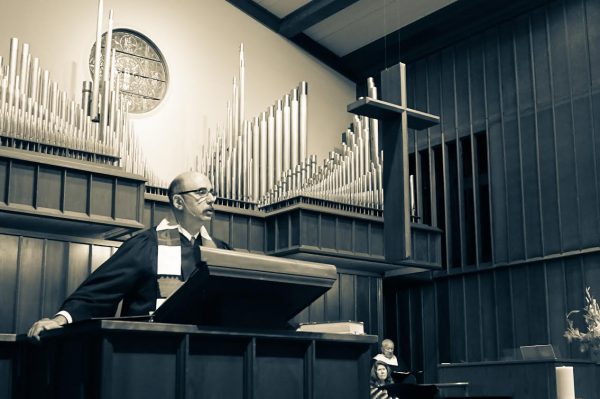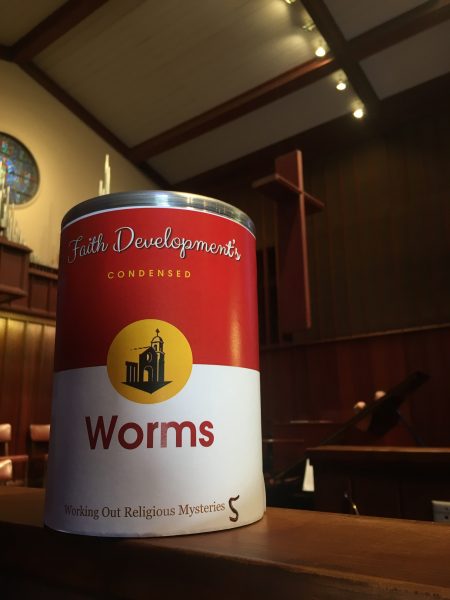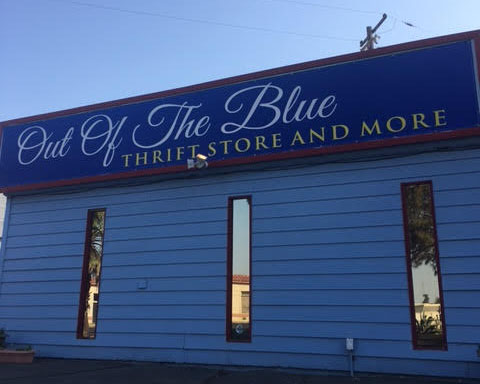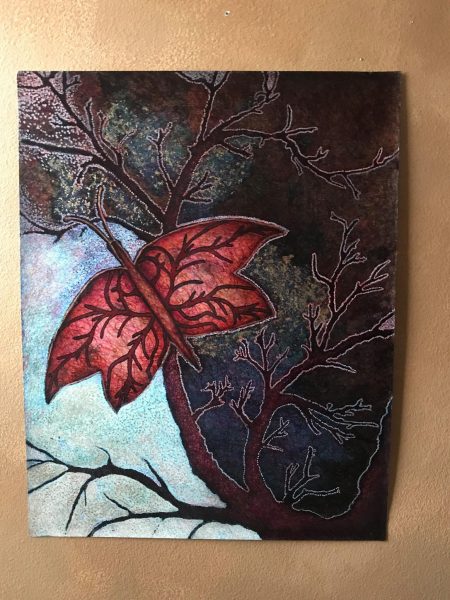Church News – Weekly Scripture Reading
Scott’s Thoughts: Focus
From Scott Baucher, Moderator
This morning I rolled out of bed at the ungodly hour of 1:35. I couldn’t sleep and had something to write. Now, it’s 3:25 and I’m just getting started. Or…more accurately…restarted…again. Ironically, the topic is focus.
For this writing, focus means concentrating and acting on a plan. The plan for 2017 and 2018 is to create a 5-year-rolling-plan called the Road to 202X (pronounced twenty, twenty X). In 2017, we are creating a 5-year-plan that will take us to 2022. Next year, we’ll review and revise the plan to take us to 2023, etc. Hence, a 5-year-rolling-plan to 202X.
While this plan is being developed, we also want to consider our “infrastructure”. This primarily includes technology for better communication, accounting, financial reporting and membership info that can connect us in more interesting and meaningful ways. Infrastructure also means talented, qualified, dedicated people as well as improved revenue and stewardship.
But let’s look beyond our own walls and boundaries. Let’s look at neighboring real estate to understand what property might fit with our sanctuary, social justice, and community connection hopes and dreams. This involves fact finding and creative input.
At this writing, we are focusing and we are making progress, thanks to so many of you! I am EXTREMELY proud of the people we have at our church. Our members, our staff, our leadership. An amazing group! We are lucky people to find ourselves surrounded and supported by so many who do so much!!
Focus. Focus on the future…the Road to 202X. Interesting? Interested? Let me know!
Your Friend in Focus,
Scott’s Thoughts
Sacred Pursuits: Let’s Talk About White Privilege — Week Three
Week Three Resources:
Video 1: Racism is Real
Video 2: TED Talk by Kandice Sumner, “How America’s Public Schools Keep Kids in Poverty”
Week Three’s readings were from Part 3 of our text.
The Cash Value of Whiteness or Whiteness as a Tax-Exempt Status
Chapter 1: Whiteness as a Tax-Exempt Status
Chapter 2: How Education Advantages Whites
Chapter 3: How Housing Practices Advantage Whites
After reading through the chapters above, give yourself some quiet time to reflect on these questions. You may choose to reflect in silent thought, process through dialogue with someone else, or use your journal as a way of recording your thoughts.
What does it mean to say that whiteness has cash value? What does it mean to say that whiteness is a taxexempt status?
Education is an economic tool. How does or doesn’t your own education translate into economic power? How would a different quality of education have affected your life?
How is your education a product of where you lived and the neighborhood you grew up in? If you had grown up in a different neighborhood, where houses were much less expensive or much more expensive, how do you imagine your experience in the classroom and in the general public sphere would have been different?
This week we will be reading from The Cash Value of Whiteness or Whiteness as a Tax-Exempt Status
Chapter 4: How Income and Wealth Disparities Advantage Whites
Chapter 5: How the Medical and Health Industries Advantage Whites
New Offering Card to Debut October First
- If you have donated electronically or by mail this week, mark it on the card and put that in the plate.
- If you offer a gift of service, such as church office volunteer, working with children or youth, interested in serving on a ministry, or helping with a special project like Crop Walk, Gay Pride Parade, or anything else that comes up in the service, then write that on the card and put it in the plate.
- Or you could “offer” a Prayer of Gratitude for something or someone that touched your life in a positive way this week, knowing that God probably had a hand in it somewhere. (Just a word or two that means something to you and to God)
World Wide Communion Sunday
 From Pastor Ara Guekguezian
From Pastor Ara Guekguezian
On Sunday we will celebrate the sacrament of Holy Communion with a variety of breads reflecting the
daily bread of the many people groups in our community. It will add to the tangible reminder of what we are doing when we receive the bread of heaven and the cup of salvation. These words are loaded with meaning, too much to unpack within even a lifetime, so thanks be to God in the person of Jesus, that we have this little meal to get it fully in a small package of time and space.
World Wide Communion was initially celebrated in 1933 beginning at Shadyside Presbyterian Church in Pittsburgh, Pennsylvania. In the midst of the Great Depression and the rise of fascism, the unity of the body of Christ would be expressed through this common act celebrated throughout the Church worldwide. By the time the U.S.A. entered the War, the remembrance on this first Sunday of October had taken hold. The Lord’s Supper was celebrated according to the way of the particular congregation or denomination in its particular way, but the words of institution were the same .
We are different in many ways from two generations ago, but we will celebrate and remember what God has done in Jesus Christ as they did in Pittsburgh in 1933 and the body of Christ has been doing for 2000 years. A variety of bread, one savior and Lord.
Meet you at the table.
Sacred Pursuits: Let’s Talk About White Privilege — Week Two
Week two resources:
If you were unable to attend, may you use these resources to begin your own work and follow along with us.
For those who attended and wanted access to the material we covered in our session, you’ve come to the right place!
Watch the video: Everyday Racism
Journaling Prompts:
- Tell a story of a time recently (maybe even today) when you were aware that being
white was equated with or presumed to be the norm? - How did that experience reflect the presence of white privilege?
- What impact did it have on you?
Download a copy of the text we will be using in our discussions.
We will be reading chapters 1–3 of Part Three — for next week’s discussion.
Prepare for week three
Can of Worms: Resurrection
 From the Faith Development Vision Group
From the Faith Development Vision Group
“Did the resurrection literally happen, or is it just a symbolic story?” That’s the question we’ll take up in the first meeting of our “Can of Worms” group next month.
Plenty of people seem to believe that the answer to that question is obvious, and they would only ever ask it rhetorically. Some would repeat Paul’s declaration to the Corinthians: “If Christ has not been raised, then our proclamation has been in vain and your faith has been in vain.” Others would remind us that extraordinary claims demand extraordinary evidence, and then argue that the evidence for a literal resurrection is less than extraordinary.
But a few of us are dissatisfied either way. How could it possibly matter, even if literally happened? Why should one man returning to life be anything but a curiosity? And if the resurrection did not really happen, then why have Christians made it into the linchpin of the world? What prompted Paul to write that faith is in vain if Christ was not raised? What was he talking about? Should it still matter for people today? How can we know?
Paul wrote that letter to the Corinthians sometime in the 50s, in the middle of the first century. It is one of the earliest texts in the New Testament, and it ought to be reliable, right? But Paul never met Jesus in the flesh, either before or after the crucifixion. So why is Paul the go-to guy on the importance of the resurrection? Did he make it up?
Some of us would have turned back by now for sure. Who questions Paul’s truthfulness in church? The rest of this little essay would be a series of assurances, reinforcing the certainty and unquestionability of the resurrection. Or it would be a curt dismissal in favor of action and getting something done. We might allow ourselves a brief, blurry glimpse at a dimly apparent middle path, but then we would move along quickly. And if anybody were to be dissatisfied by that, well, we would leave them there alone with it. This is church, and we are all certain here—wrestle with doubt on your own time. (Or: this is the modern world, so come to your senses and do some science!)
Not here at the Big Red Church. Here, we are open and affirming, and we mean that broadly: we affirm the diversity that exists among us, we stand with those who suffer isolation and alienation, and we celebrate the variety of perspectives that enrich us in ways that we might not predict or envision. (At least, that’s what we print in the bulletin every week.) If the church is not a safe place to wrestle with stuff that gets under your skin, then how safe can it be? If some questions cannot be asked, then how strong are we, really?
Not everybody needs to ask these questions, just like not everybody needs to sing in the choir, and not everybody needs to join a committee. (Or, as Paul wrote to the Romans: “Those who eat must not despise those who abstain, and those who abstain must not pass judgment on those who eat; for God has welcomed them.”) But if you need to ask, and if you need to search the depths of mystery, then join us on Monday, October 16, at 7:00 p.m. in the Heritage Room, where we intend to open this “Can of Worms” together.
Sacred Pursuits: Let’s Talk About White Privilege — Week One Resources
We had our first gathering of six to begin our work on unpacking our privilege so we can become better allies as we work toward justice for all.
If you were unable to attend, may you use these resources to begin your own work and follow along with us.
For those who attended and wanted access to the material we covered in our session, you’ve come to the right place!
Watch the video: Deconstructing White Privilege with Dr. Robin Di Angelo
Journaling Prompts:
- How did you first come to learn about and recognize the differences between people of different races?
- Who taught you what characteristics were ascribed to your race and the races of others around you?
- How does what you learned then impact your ability to talk about race now?
Download a copy of the text we will be using in our discussions.
We will be reading Part Two — Whiteness as the Norm: Five Loci of Insights on the Binary of Light/Dark and Black/White for next week’s discussion.
Prepare for week two
Leaps of Faith Sometimes Come Out of the Blue

From Kim Williams,
Director of Facilities, Communication, and Technology
(and enthusiast of all things vintage)

Pat Morales, our FCCF Facilities Caretaker, wedding Coordinator, Event Genius, and all around amazing human being, has taken a gigantic leap of faith and has opened Out of the Blue Thrift Store. The thrift shop is located in the corner lot at Echo and Weldon.
“I called it Out of the Blue, because that’s where it came from—out of the blue!”
Morales is no stranger to business ownership, having owned and operated two pizza parlors, and a coffee shop that was located in the space that Ampersand now occupies. She says that when she saw the building was for lease, she couldn’t pass up the opportunity to turn a neighborhood eyesore into a place where folks can find new treasures.
In a fly-by-the-seat-of-her pants move, she opened her doors yesterday and says that she had 15 customers by the end of the day—and this without any promotion, simply a sign saying “Now Open.”

She plans on using her perfectly situated spot, next door to Fresno Art Hub and across the street from A Sense of Place Art Gallery to participate in Art Hop. Out of the Blue will be hosting local artist (and member of our congregation) Kirk Cruz showing his intricate and unique sharpie-marker art pieces tonight during Art Hop from 5pm–8pm.
If you’d like to support both Pat and Kirk, please drop by 2004 N Van Ness Blvd tonight. Congrats to Pat Morales on your new venture, and thank you for loving our neighborhood so much that you wanted to become a business owner here too.